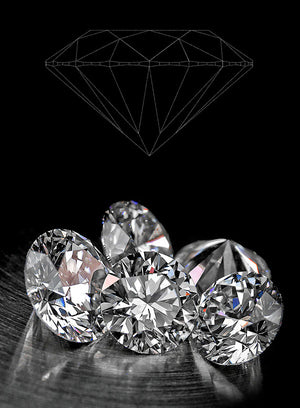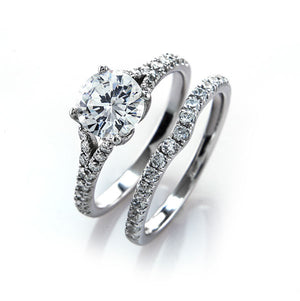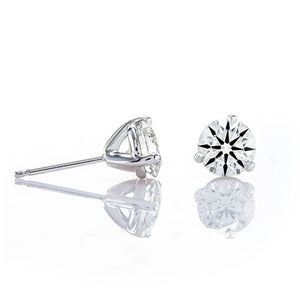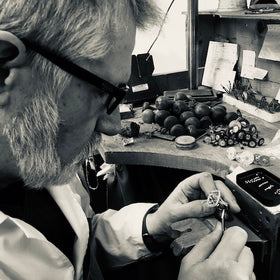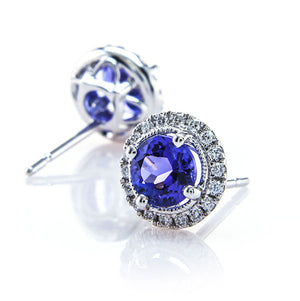
What are the Standards for Ideal Cut Diamonds?
(Updated 12/6/18. Originally Published 5/21/14)
Throughout time, diamond cutters have strived to perfect the balance between maximizing light return, visual performance, and the retention of carat weight. In 1919, Marcel Tolkowsky, a mathematician and member of a prominent diamond cutting family, developed the formula which the modern round brilliant ideal cut diamond is based upon.
The Tolkowsky Ideal Cut Diamond:
Tolkowksy’s Diamond Design was based on modern theories of light behavior; however it is important to consider the fact that he lived during the time when the world was transitioning from candlelight to electric light, and thus the lighting environments which he based his calculations and findings upon, are not the same lighting environment which we rely upon today. Tolkowsky’s standard for ideal cut diamonds called for a total depth of 59.3% with a table diameter of 53% and a crown angle of 34.5 degrees, which is offset by a pavilion angle of 40.75 degrees, however apparently he never accounted for the girdle edge of the diamond.
Perhaps Tolkowsky omitted the girdle edge measurement because it is not a super critical component of light return in terms of the volume of light being created, however how the facets which create the girdle edge are formed can have a direct effect upon the visual performance; or possibly he just intended the girdle thickness to be added on top of the 59.3% which he specified as the ideal depth for a round brilliant cut diamond…
Suffice to say that adjustments have been made to Tolkowsky’s Diamond Design of 1919, to account for the lack of a girdle edge in his calculations, transitions in the lighting environments which we live and work within, and advances in diamond cutting technology.
One of those advancements is computerized mathematical ray tracing and proportions analysis, which enables us to accurately determine the proportions of a diamond without having to visually estimate them, and to model the behavior of light as it travels through a diamond of those proportions.
An important thing to keep in mind while searching for your perfect diamond, is that the machines which measure diamonds and calculate their proportions, provide average measurements for the crown and pavilion angle measurements, and they round those measurements off, so don’t bother scouring the globe for a diamond with a pavilion angle of 40.75 degrees because the machines will round that measurement up to 40.8 degrees, and would round it down to 40.7 degrees if the average measurement was 40.74 degrees.
The American Ideal Cut Diamond:
As is often the case, the well recognized work of one person, is often based upon the ideas and concepts shared by other people within the community who are working towards a common goal of improving something which they are passionate about, and this seems to be the case with Marcel Tolkowky’s Diamond Design, because in his writing he referred to a new breed of diamond cutter whose goal was to cut diamonds with the liveliest fire and greatest brilliancy.
One of the diamond cutters who had been working towards that goal, was a diamond cutter named Henry Morse, who operated a diamond cutting factory in Boston, Massachusetts, and was known to have been re-cutting Old European Cut diamonds to within a one degree variance of 41.0 degrees and a crown angle which is as close to 35 degrees as possible.
Eventually diamond cutters in America adapted their production of round brilliant cut diamonds based upon the findings of diamond cutters like Henry Morse and Marcel Tolkowksy, and produced what became known as the American Ideal Cut Diamond, which is cut to the following range of proportions:
- Total depth between: 59.9 – 63%
- Table diameter between 53 – 57.5%
- Crown angle between 33.7 – 35.8 degrees
- Pavilion angle between 40.5 – 41.5 degrees
- Girdle edge between 0.7 – 2.9% thick
And these are the measurements which the widely recognized AGS Ideal-0 cut diamond were based upon when the American Gem Society proportions based grading platform was first introduced in the mid-1990’s.
The AGS Ideal-0 Cut Diamond:
The AGS Ideal-0 Cut Diamond is probably the most widely recognized definition for an ideal cut diamond, possibly because the power of the internet has made it possible for diamond buyers all over the world to learn more about diamonds via the wealth of diamond grading information and tutorials to be found on sites like Brian Gavin Diamonds, who focus on diamond cut quality and the light performance which results from it.
The proportions based grading platform which was initially relied upon by the American Gem Society Laboratory (AGSL) was replaced by their the Light Performance based grading platform in 2005, which relies upon Angular Spectrum Evaluation Technology (ASET) to grade diamonds for eleven factors which contribute to light performance, this differs dramatically from the overall cut grade of GIA Excellent, which is the highest grade available from the Gemological Institute of America (GIA) which takes only polish, symmetry, and proportions into account.
Regardless of the differences in the parameters for all the types of ideal cut diamonds which are available, there is an ideal cut diamond for every preference and that is the subject of the next article.





